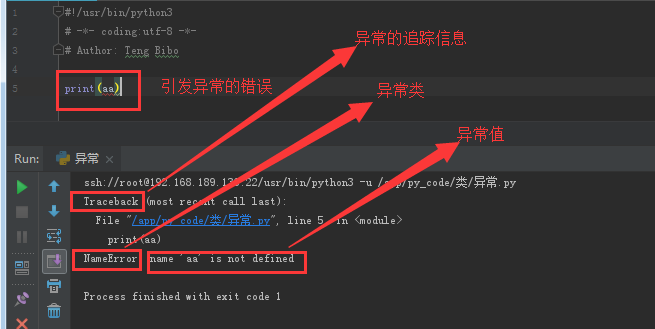一 什么是异常
异常就是程序运行时发生错误的信号(在程序出现错误时,则会产生一个异常,若程序没有处理它,则会抛出该异常,程序的运行也随之终止),在python中,错误触发的异常如下

而错误分成两种

#语法错误示范一 if #语法错误示范二 def test: pass #语法错误示范三 class Foo pass #语法错误示范四 print(haha

#TypeError:int类型不可迭代 for i in 3: pass #ValueError num=input(">>: ") #输入hello int(num) #NameError aaa #IndexError l=['egon','aa'] l[3] #KeyError dic={'name':'egon'} dic['age'] #AttributeError class Foo:pass Foo.x #ZeroDivisionError:无法完成计算 res1=1/0 res2=1+'str'
二 异常种类
在python中不同的异常可以用不同的类型(python中统一了类与类型,类型即类)去标识,一个异常标识一种错误

AttributeError 试图访问一个对象没有的树形,比如foo.x,但是foo没有属性x IOError 输入/输出异常;基本上是无法打开文件 ImportError 无法引入模块或包;基本上是路径问题或名称错误 IndentationError 语法错误(的子类) ;代码没有正确对齐 IndexError 下标索引超出序列边界,比如当x只有三个元素,却试图访问x[5] KeyError 试图访问字典里不存在的键 KeyboardInterrupt Ctrl+C被按下 NameError 使用一个还未被赋予对象的变量 SyntaxError Python代码非法,代码不能编译(个人认为这是语法错误,写错了) TypeError 传入对象类型与要求的不符合 UnboundLocalError 试图访问一个还未被设置的局部变量,基本上是由于另有一个同名的全局变量,导致你以为正在访问它 ValueError 传入一个调用者不期望的值,即使值的类型是正确的

ArithmeticError
AssertionError
AttributeError
BaseException
BufferError
BytesWarning
DeprecationWarning
EnvironmentError
EOFError
Exception
FloatingPointError
FutureWarning
GeneratorExit
ImportError
ImportWarning
IndentationError
IndexError
IOError
KeyboardInterrupt
KeyError
LookupError
MemoryError
NameError
NotImplementedError
OSError
OverflowError
PendingDeprecationWarning
ReferenceError
RuntimeError
RuntimeWarning
StandardError
StopIteration
SyntaxError
SyntaxWarning
SystemError
SystemExit
TabError
TypeError
UnboundLocalError
UnicodeDecodeError
UnicodeEncodeError
UnicodeError
UnicodeTranslateError
UnicodeWarning
UserWarning
ValueError
Warning
ZeroDivisionError
三 异常处理
为了保证程序的健壮性与容错性,即在遇到错误时程序不会崩溃,我们需要对异常进行处理,
如果错误发生的条件是可预知的,我们需要用if进行处理:在错误发生之前进行预防

AGE=10 while True: age=input('>>: ').strip() if age.isdigit(): #只有在age为字符串形式的整数时,下列代码才不会出错,该条件是可预知的 age=int(age) if age == AGE: print('you got it') break
如果错误发生的条件是不可预知的,则需要用到try...except:在错误发生之后进行处理

#基本语法为 try: 被检测的代码块 except 异常类型: try中一旦检测到异常,就执行这个位置的逻辑 #举例 try: f=open('a.txt') g=(line.strip() for line in f) print(next(g)) print(next(g)) print(next(g)) print(next(g)) print(next(g)) except StopIteration: f.close()
异常类只能用来处理指定的异常情况,如果非指定异常则无法处理。
s1 = 'hello' try: int(s1) except IndexError as e: # 未捕获到异常,程序直接报错 print(e) Traceback (most recent call last): File "<pyshell#36>", line 2, in <module> int(s1) ValueError: invalid literal for int() with base 10: 'hello'
所以,写程序时需要考虑到try代码块中可能出现的任意异常,可以这样写:

s1 = 'hello' try: int(s1) except IndexError as e: print(e) except KeyError as e: print(e) except ValueError as e: print(e) invalid literal for int() with base 10: 'hello'
在python的异常中,有一个万能异常:Exception,他可以捕获任意异常,即:

s1 = 'hello' try: int(s1) except Exception as e: print(e) invalid literal for int() with base 10: 'hello'
如果你想要的效果是,无论出现什么异常,我们统一丢弃,或者使用同一段代码逻辑去处理他们,那么骚年,大胆的去做吧,只有一个Exception就足够了。如果你想要的效果是,对于不同的异常我们需要定制不同的处理逻辑,那就需要用到多分支了。
也可以在多分支后来一个Exception,对于特殊处理或提醒的异常需要先定义,最后定义Exception来确保程序正常运行。

s1 = 'hello' try: int(s1) except IndexError as e: print(e) except KeyError as e: print(e) except ValueError as e: print(e) except Exception as e: print(e) invalid literal for int() with base 10: 'hello'
异常其他结构:
s1 = 'hello' try: int(s1) except IndexError as e: print(e) except KeyError as e: print(e) except ValueError as e: print(e) else: print('try 内代码块没有异常则执行我') finally: print('无论异常与否,都会执行该模块,通常是进行清理工作') # 输出 invalid literal for int() with base 10: 'hello' 无论异常与否,都会执行该模块,通常是进行清理工作
主动触发异常

try: raise TypeError('类型错误') except Exception as e: print(e) #输出 类型错误
自定义异常

class EgonException(BaseException): def __init__(self,msg): self.msg = msg def __str__(self): return self.msg try: raise EgonException('类型错误') except EgonException as e: print(e) #输出 类型错误
断言

# assert 条件 assert 1 == 1 assert 1 == 2
总结 try ... except
1. 把错误处理和真正的工作分开来;
2. 代码更易组织,更清晰,复杂的工作任务更容易实现;
3. 毫无疑问,更安全了,不至于由于一些小的疏忽而使程序意外崩溃了;
